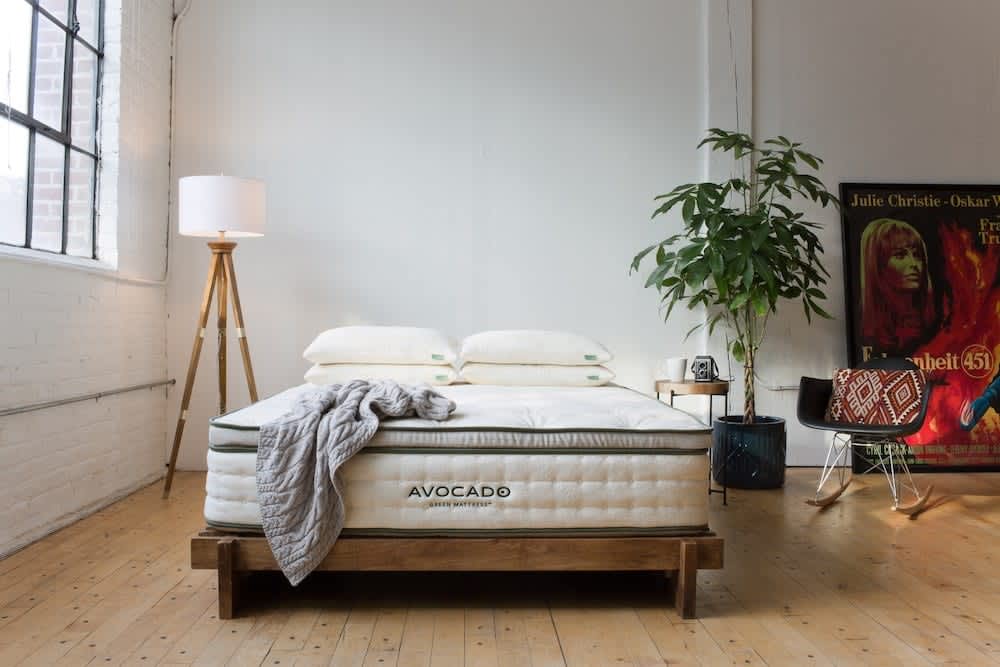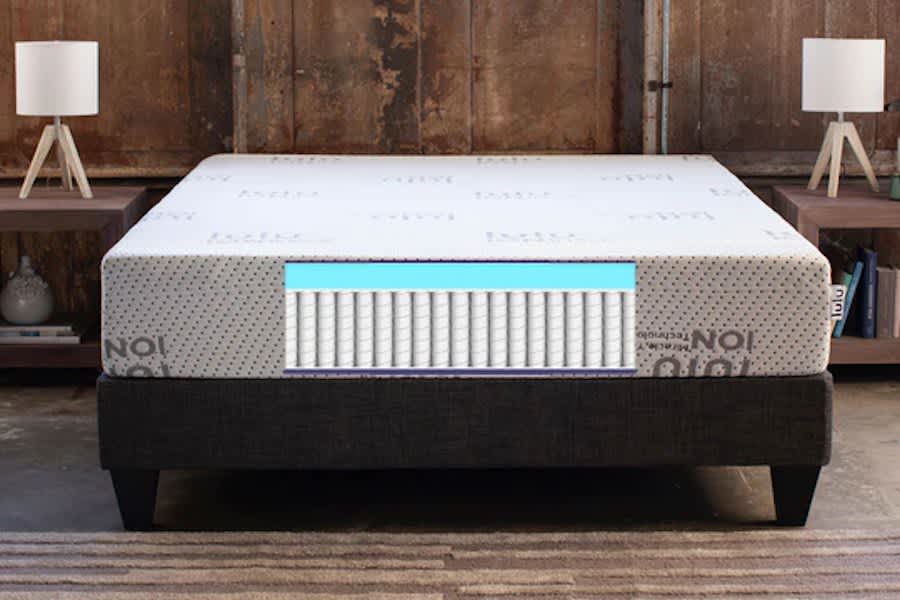On This Page
The Best Innerspring Mattress of 2025
Our Top Picks
-
Best Overall Mattress
Saatva Classic -
Best Value Mattress
Brooklyn Bedding Signature Hybrid -
Best Mattress for Side Sleepers
Helix Midnight Luxe -
Best Organic Mattress
Avocado Green Mattress -
Best Mattress for Couples
Lulu Hybrid
Best Overall Mattress

The Saatva Classic delivers the support and bounce sleepers expect from a traditional innerspring, but you'll also notice some gentle contouring from the memory foam lumbar pad. Three firmness options are available, allowing you to choose the most comfortable feel based on your body type and sleep position.
Pros & Cons
Pros
- Coil-on-coil design is exceptionally sturdy and responsive to movement
- Available in three firmness levels
- All orders include free White Glove delivery and a 365-night trial
Cons
- Limited motion isolation for couples
- Expensive sticker price and $99 return fee
Ratings
Our Take
Best Value Mattress

The Brooklyn Bedding Signature Hybrid is versatile, affordable, and a strong performer in several key testing areas such as temperature control and pressure relief. You can choose from three firmness levels based on your body type and primary sleep position.
Pros & Cons
Pros
- Contouring comfort system relieves pressure while coils maintain responsiveness
- Available in three firmness levels
- Budget-friendly without sacrificing durability
Cons
- Motion transfers easily on the firm model
- $99 fee deducted from mattress returns
Ratings
Our Take
Best Mattress for Side Sleepers

Thick foam layers set the Helix Midnight Luxe apart from traditional innersprings in terms of contouring and pressure relief. These qualities make the mattress particularly well suited to side sleepers who need extra cushioning for their shoulders and hips.
Pros & Cons
Pros
- Thick foam layers contour evenly to align the spine and reduce pressure buildup
- Zoned coils push back against extra weight in the torso and hips
- Two cooling cover options
Cons
- May lack sufficient support for back and stomach sleepers over 230 pounds
- Foam layers emit strong off-gassing odor for the first few nights
Ratings
Our Take
Best Organic Mattress

Available as a firmer standard model or a gentler Euro-top design, the Avocado Green maintains even support for most sleepers thanks to its responsive latex comfort layer and zoned coil system. All U.S. orders include a generous 365-night sleep trial.
Pros & Cons
Pros
- Features certified organic materials
- Zoned coils offer targeted support with notable bounce
- Virtually no off-gassing or smell after unboxing
Cons
- Side sleepers under 130 pounds may not receive enough cushioning
- Bounce from coils and latex may allow some motion transfer
Ratings
Our Take
Best Mattress for Couples

The Lulu Hybrid has a balanced medium firm (6) feel, sturdy perimeter, and a thick foam comfort layer to absorb motion — all important attributes for co-sleepers. Our team also enjoyed the hybrid’s cooling cover that captures and releases heat on contact, resulting in a surface that feels cool at all times.
Pros & Cons
Pros
- Memory foam hybrid design offers even contouring and sturdy support
- Proprietary ION cover is engineered to dissipate heat and promote physical recovery
- Pocketed coils have a reinforced perimeter to boost edge support
Cons
- Lacks the thick cushioning typically preferred by side sleepers under 130 pounds
- The hug of memory foam may restrict some movement on the mattress
Ratings
Our Take
Compare Our Top Picks
| Mattress | Mattress Type | Ideal For | Value | Sleep Trial |
| Saatva Classic | Innerspring | Back Sleepers | Fair Value | 365 Nights ($99 Return Fee) |
| Brooklyn Bedding Signature Hybrid | Hybrid | Couples | Great Value | 120 nights (30-night requirement) |
| Helix Midnight Luxe | Hybrid | Combination Sleepers | Good Value | 120 nights (30-night requirement) |
| Avocado Green Mattress | Latex Hybrid | Couples | Good Value | 365 nights (30-night break-in period) |
| Lulu Hybrid | Hybrid | Couples | Fair Value | 101 nights (28-night requirement) |
One thing you can count on with innerspring mattresses is support. The amount of support will vary depending on the materials and thickness of the comfort layers, but innersprings are a good place to start if you need a certain amount of sturdiness and responsiveness from your mattress.
What Is an Innerspring Mattress?
An innerspring mattress is powered by a thick layer of metal coils that gives this bed type its characteristic bounce and sturdiness. The number of coils and their thickness impacts the feel, durability, and bounce of the mattress.
Modern innersprings typically use pocketed coils that are individually wrapped with fabric. This gives each coil an enhanced ability to compress independently of the ones around it. In some mattresses, the coils are arranged into zones with thicker coils around the perimeter or under heavier parts of the body like the midsection.
Above the coils, modern innerspring mattresses may have additional layers that influence the firmness level and performance, known as the comfort system. The materials in these layers can include polyfoam, memory foam, cotton, wool, or latex.
Types of Innerspring Coils
Innerspring mattresses can be constructed with different types of coils, which influences the bed’s performance and feel.
| Coil Type | Description |
| Bonnell Coils | These hourglass-shaped coils have been used for decades in innerspring mattresses and are often found in lower-cost models. Spiral wires connect the coils, which can increase the likelihood of motion transfer and noise from the coils. |
| Offset Coils | At first glance, these coils can look like Bonnell coils, but they are squared on the top and bottom, giving them increased hinging action. Their structure can increase pressure relief and reduce motion transfer, but this usually comes at a higher cost. |
| Continuous Wire Coils | These coil systems are built from one metal wire that is shaped into rows of coils. With their straightforward design, continuous wire coils are sturdy and typically have a lower price-point. However, they generally cause more motion transfer and provide less tailored spinal support. |
| Pocketed Coils | In a pocketed coil system, each spring is wrapped in fabric, giving them more independent range of motion. This boosts their ability to adapt to the body and isolate motion. Their performance and durability make them popular in modern innerspring and hybrid mattresses, but they are usually more expensive than other types of coils. |
Innersprings vs. Other Mattress Types
Compared to other mattress types, innerspring mattresses tend to provide more bounce, edge support, and temperature neutrality. Their contouring and pressure relief can vary based on their top layers, but innersprings typically do not provide the deep hug offered by many foam mattresses.
Like innersprings, hybrid mattresses are also built with a coil support core, so it can be hard to tell the difference between the two. Confusing matters, some hybrids are marketed as innersprings, and vice versa. What sets them apart is that hybrids generally have a more robust comfort system involving thicker layers above the coils, which often results in increased pressure relief and motion isolation.
Video: How Do the Big Mattress Types Compare?
Watch our video to learn more about which type of mattress is best for you.
Is an Innerspring Mattress Right for You?
Because they usually have a firmer feel with less contouring, innerspring mattresses often provide the right level of spinal support for back and stomach sleepers. The metal coils typically create a robust feel with significant responsiveness, while airflow through the coils helps keep the mattress from overheating, making innersprings a solid option for hot sleepers.
You should generally avoid an innerspring mattress if you want a soft feel or a mattress with deep contouring. An innerspring may not be a good fit if you prefer a bed with less bounce and minimal motion transfer.
| Advantages | Drawbacks |
|
|
How to Choose an Innerspring Mattress
When choosing an innerspring mattress, it can be helpful to look at details like the type, number, and thickness of the coils. Other important considerations include pressure relief, overall comfort, and pricing.
Coil Gauge and Count
The coil count, or total number of coils, increases with the size of the mattress. While the total count can be informative, it is often more helpful to know about the type of coils and their gauge, or thickness.
Lower-gauge coils are thicker, generally more durable, and provide a firmer feel. Some innerspring mattresses combine coils of different gauges, such as lower-gauge coils around the perimeter or underneath the midsection.
Pressure Relief
Innerspring mattresses can deliver pressure relief, but they typically provide less contouring than memory foam or hybrid models. Among innerspring models, those with pocketed coils are best able to cushion and adapt to the body’s main pressure zones.
If you experience body pain or need deeper contouring, you may want to consider another type of mattress or look for an innerspring with a soft top layer made with a conforming material.
Comfort
What feels most comfortable is subjective, so you’ll want to make sure an innerspring mattress aligns with your preferences. For example, you’re most likely to feel comfortable on an innerspring if you prefer a firmer feel and some bounce, or if you sleep hot and need a bed with minimal heat retention.
Pricing
Innerspring mattresses can cost anywhere from less than $200 to more than $2,000 depending on the brand, size, materials, and features.
Traditional models with a basic, thinner coil system are often available at budget prices, while more robust and durable models with pocketed coils tend to cost more. Adding premium materials and luxury features has a corresponding boost to the sticker price.
Discover More Mattress Solutions
Take a look at some of our other mattress buying guides, where we offer more expert guidance to ensure you find the perfect fit for your sleep needs.
More Mattress Types
How We Test
To find the best innerspring mattresses, our team researched and tested dozens of models using our detailed product testing methodology. We include input from team members who have varying comfort preferences, body weights, and preferred sleep positions. Our goal is to provide well-rounded and dependable recommendations for mattress shoppers with diverse needs and preferences.
Frequently Asked Questions
The best innerspring mattress should have key characteristics like responsiveness, durability, edge support, and temperature neutrality. Most often, you’ll find these elements in an innerspring with pocketed coils. Depending on your sleep needs, the best innerspring mattress for you may have additional layers designed to enhance pressure relief and overall comfort.
Innersprings are best for people who want a bouncy mattress with less contouring and sink, such as many stomach and back sleepers and people who sleep hot or need reliable edge support. People who prefer deep contouring and strong pressure relief generally should avoid innerspring mattresses.
The average innerspring mattress lasts about five to seven years. Lower-quality models with thin or cheaply made coils may not last as long. Sturdier models with thick pocketed coils may hold up for longer than seven years. The total lifespan also depends on how much pressure you put on your mattress and how well you maintain it.
Innerspring mattresses can work for some side sleepers, but they usually aren’t the best option for this sleeping position. Many innersprings don’t provide the cushioning that side sleepers need for their shoulders and hips. That said, some innersprings with pocketed coils and contouring comfort layers can deliver sufficient pressure relief to side sleepers.
Innerspring mattresses can be beneficial in minimizing back pain for some people, such as back and stomach sleepers. People who sleep in these positions can develop lower back pain if their midsection sinks too deeply into the bed. The firmness and support of an innerspring can prevent this sinkage and help maintain healthy spinal posture that limits back pain.
Traditional innerspring mattresses are designed to be placed on a box spring, but using a box spring is either optional or not recommended for modern models with pocketed coils. If the mattress is compatible, a box spring can add stability, height, and firmness. It may also contribute to greater long-term durability.
We suggest checking with the manufacturer of your innerspring mattress to see whether a box spring is recommended. The mattress warranty will typically specify which types of bed bases are acceptable.
